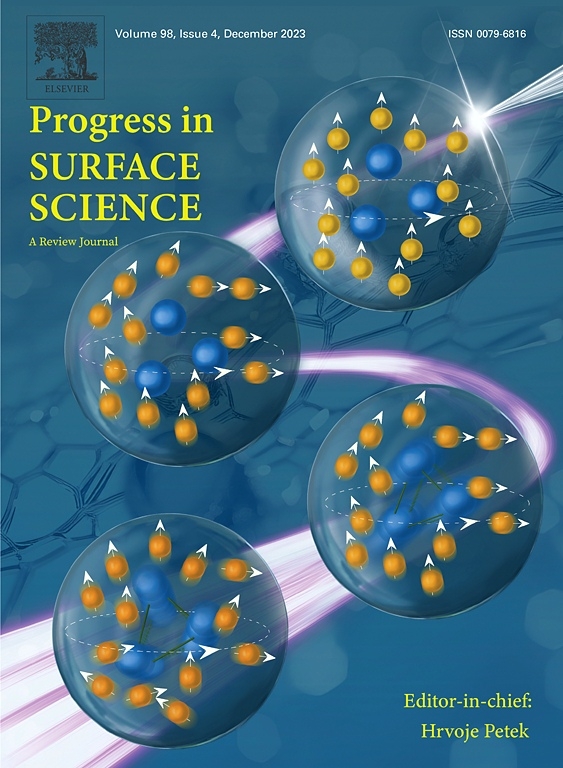Nonperturbative quantum theory of multiplasmonic electron emission from surfaces: Gauge-specific cumulant expansions vs. Volkov ansatz over plasmonic coherent states
IF 7.2
2区 工程技术
Q1 CHEMISTRY, PHYSICAL
引用次数: 0
Abstract
Energetic electromagnetic fields produce a variety of elementary excitations in solids that can strongly modify their primary photoemission spectra. Such is the plasmon excitation or pumping mechanism which, although indirect, is very efficient and hence may give rise to formation of plasmonic coherent states. In turn, these states may act as a source or sink of energy and momentum for escaping electrons. Starting from the model Hamiltonian approach we show that prepumped plasmonic bath of coherent states gives rise to ponderomotive potentials and Floquet electronic band structure that support multiple plasmon-induced electron emission or plasmoemission from metals. Theoretical description of multiple plasmoemission requires a nonperturbative approach which is here formulated by applying cumulant expansion and Volkov ansatz to the calculations of electron wavefunctions and emission rates. The calculations are performed in the standard length gauge as well as in the Pauli-transformed velocity gauge for electron–plasmon interaction. The applicability of two nonperturbative approaches to calculation of excitation amplitudes are examined in each gauge. They smoothly interpolate between the fully quantal first order Born approximation and semiclassical multiplasmon-induced electron excitation limit. This is illustrated on the example of plasmoemission from Floquet surface bands on Ag(111) from which this channel of electron yield has been detected. Our calculations indicate that even subsingle mode occupations of plasmonic coherent states can support multiplasmon electron emission from surface bands. A way of calibration of plasmonic coherent states is proposed.
表面多等离子体电子发射的非微扰量子理论:等离子体相干态上的量规特异性累积膨胀与Volkov ansatz
高能电磁场在固体中产生各种各样的基本激发,可以强烈地改变它们的初级光发射光谱。这就是等离子激元激发或泵送机制,虽然是间接的,但非常有效,因此可以引起等离子相干态的形成。反过来,这些状态可以作为逃逸电子的能量和动量的源或汇。从模型哈密顿方法出发,我们证明了相干态的预泵送等离子体浴产生了重动势和Floquet电子带结构,支持多等离子体诱导的电子发射或金属的等离子体发射。多等离子体发射的理论描述需要一种非微扰的方法,这里通过应用累积展开和Volkov ansatz来计算电子波函数和发射率。计算是在标准长度计和电子-等离子体相互作用的泡利变换速度计中进行的。研究了两种非摄动方法在每个量规中计算激励幅值的适用性。它们平滑地插补在全量子一阶玻恩近似和半经典多等离子体诱导电子激发极限之间。Ag(111)上的Floquet表面带的等离子体发射的例子说明了这一点,从这个例子中可以检测到这个电子产率通道。我们的计算表明,即使是亚单模占据的等离子体相干态也可以支持表面带的多等离子体电子发射。提出了一种等离子体相干态的标定方法。
本文章由计算机程序翻译,如有差异,请以英文原文为准。
求助全文
约1分钟内获得全文
求助全文
来源期刊

Progress in Surface Science
工程技术-物理:凝聚态物理
CiteScore
11.30
自引率
0.00%
发文量
10
审稿时长
3 months
期刊介绍:
Progress in Surface Science publishes progress reports and review articles by invited authors of international stature. The papers are aimed at surface scientists and cover various aspects of surface science. Papers in the new section Progress Highlights, are more concise and general at the same time, and are aimed at all scientists. Because of the transdisciplinary nature of surface science, topics are chosen for their timeliness from across the wide spectrum of scientific and engineering subjects. The journal strives to promote the exchange of ideas between surface scientists in the various areas. Authors are encouraged to write articles that are of relevance and interest to both established surface scientists and newcomers in the field.
 求助内容:
求助内容: 应助结果提醒方式:
应助结果提醒方式:


